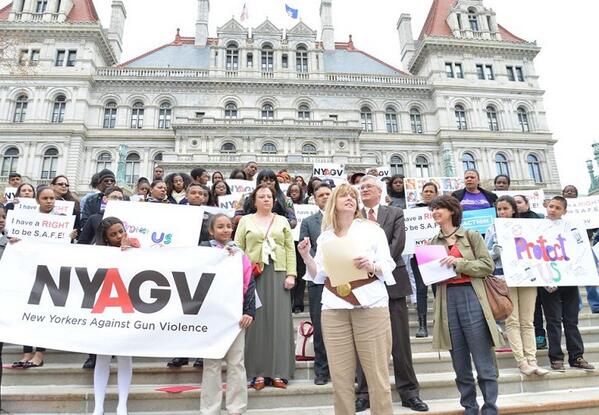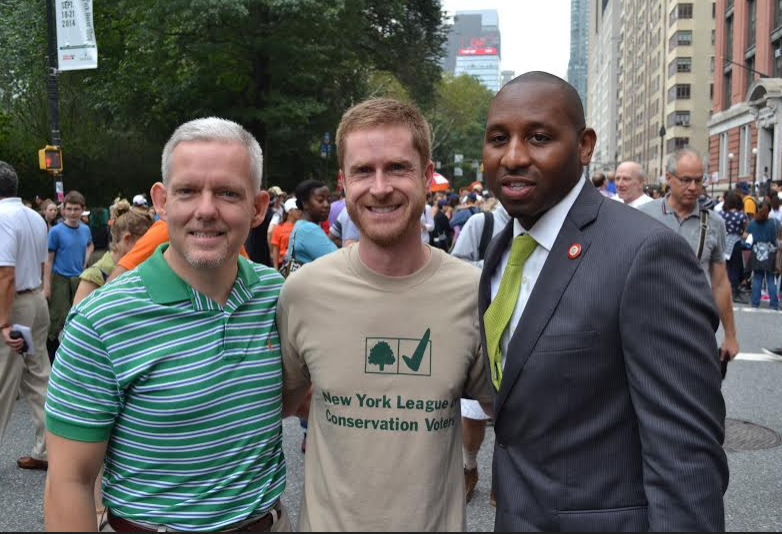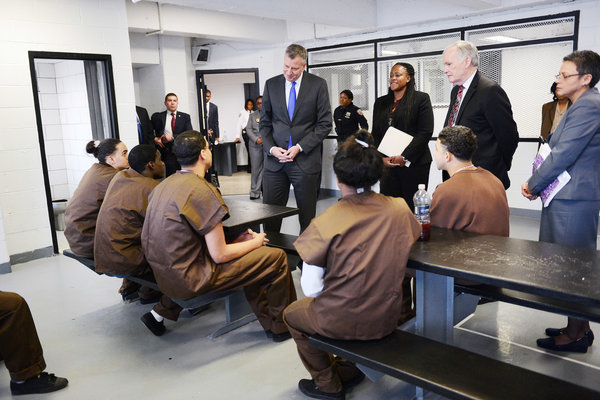Pass Nicholas' Law, Increase Protection for Children from Guns

A NYAGV rally in Albany (photo: @NYAGV1)
On December 22, 2010, Oxsana Naumkin received a phone call no parent should ever get. She was told, "Nicholas has been shot." Her 12-year-old son, Nicholas, had been fatally shot while on a playdate by a friend who found his father's loaded and unlocked 9mm handgun in a dresser drawer.
The adult responsible received a $250 fine and was ordered to surrender his weapons.
According to federal data from the Centers for Disease Control, between 2007 and 2013 an average of 62 children aged 14 and under died each year in unintentional shootings. But a 2014 study by Everytown for Gun Safety shows these deaths are significantly undercounted. The study revealed that at least 100 children were killed in unintentional shootings from December 2012 to December 2013 - almost 2 children per week and 61% more than federal data show. Nearly 85% of these deaths happened in a home or vehicle belonging to the family, a friend, or relative of the victim, as in the case of Nicholas Naumkin, most often with guns that were legally owned but not locked up.
As well as being killed, children are often unintentionally injured by guns. In New York State an average of 210 children aged 19 and under are treated annually in a hospital because of an unintentional firearm injury.
Although the shooting death of Nicholas Naumkin was called an 'accident' by the media, where children and guns are involved, there is no such thing as an accident.
These deaths and injuries are preventable. We protect our children from household poisons, secure them in car seats and with seat belts, install stair guards, child-proof light sockets, and fence in our swimming pools. Shouldn't we also be concerned about a product owned by 30% of American households that was designed to kill?
Nearly two million children live with unsecured guns. In New York, 38% of gun owners reported some form of unsafe storage.
Many parents underestimate the extent to which their children know where guns are stored and how often their children handle these guns without adult supervision. A Harvard study showed that 70% of children under the age of 10 know where a parent keeps the household gun and 36% of the children reported handling the weapon.
The American Academy of Pediatrics (AAP) strongly advises homes with kids to be gun free. That's because a gun in the home is far more likely to kill someone known to the family than to kill or injure an intruder.
A gun in the home also triples the risk of homicide and increases the risk of suicide by 5 times. If parents or caregivers do own a gun, the AAP urges the adults to be responsible and lock them up, separate from the ammunition, so children can't gain access.
Unsecured guns in the home also contribute to youth suicides. Nationally, suicides in children and youth from the ages of 10–19 hit a twelve-year high in 2013. Gun suicides are now the second leading cause of death among children and teens after car deaths, replacing gun homicides. Sixteen New York children and teens committed suicide with a gun in 2013.
Educating parents about safe gun storage is important. Before they send their child to another home, parents should ask, "Is there an unlocked gun in your house?" Oxsana Naumkin is convinced had she asked this question, Nicholas may still be alive.
But safe storage laws are also important. There is strong evidence that Child Access Prevention (CAP) Laws can reduce the number of children killed or injured in unintentional shootings and significantly reduce youth suicides. CAP laws make gun owners, whose unsecured guns result in harm, subject to criminal liability.
Twenty-eight states and the District of Columbia have some form of safe storage law. Many people may be surprised to learn that New York, a state with relatively strong gun safety laws, does not have a Child Access Prevention law. Even Texas and Florida have CAP laws.
That's why New Yorkers Against Gun Violence is advocating for Nicholas' Law (A.53/S.2291), named for Nicholas Naumkin. The law would require guns not in the immediate possession of the owner to be stored in a safe or other secure container with a locking device, to prevent access by children. Gun owners who fail to comply will be subject to criminal liability ranging from a violation to a felony, depending on the harm that results.
The New York State Coalition to Prevent Child Access to Guns is calling for the enactment of Nicholas' Law and has over fifty member organizations, including the American Academy of Pediatrics, the NY State Nurses Association, the NY State PTA, the League of Women Voters, and the NY State Chapter of Moms Demand Action for Gun Sense in America.
New York must do everything it can to protect children from the dangers of unsecured guns in the home.
***
Leah Gunn Barrett is the Executive Director of New Yorkers Against Gun Violence
Sign the petition for Nicholas' Law at www.nyagv.org. Your organization can join the NY State Coalition to Prevent Child Access to Guns by emailing This email address is being protected from spambots. You need JavaScript enabled to view it.
***
Have an op-ed idea or submission for Gotham Gazette? E-mail editor Ben Max: This email address is being protected from spambots. You need JavaScript enabled to view it.
Queens Deserves Better Transportation

Council Members Van Bramer, left, and Rchards, right, flank an advocate
When Rockaway Peninsula's only subway connection to Manhattan – the A Train – was not in service for seven months after Hurricane Sandy, it shined a bright light on the inadequate transit options the outer boroughs rely on. The Rockaways, however, weren't just cut off from Manhattan, they were isolated from the rest of Queens.
Last year, 4.1 million people visited the Rockaways – a 25 percent increase over 2012. But the Rockaways are more than just a destination, they are a starting point for residents who travel to work, school, and doctor appointments throughout the city. As more people make their way to Queens, we stand at a pivotal juncture. Yet, we do not have the transportation infrastructure in place to support this kind of growth. From Far Rockaway and Arverne to Jackson Heights and Woodside, there is a need for something better.
In his State of the City Address, Mayor de Blasio not only outlined his support for improved public transportation, but specified the role that bus rapid transit would play in the borough of Queens.
An important step in solving the problem of inadequate transportation infrastructure is the introduction of a Select Bus Service (SBS) corridor that includes full-featured Bus Rapid Transit (BRT) where feasible along Woodhaven and Cross Bay Boulevards, extending to Far Rockaway.
SBS is designed to reduce travel time with off-board fare collection and bus lanes painted a different color than others. Full-featured BRT includes dedicated, center-median bus lanes, traffic signal prioritization, platform level boarding, and protected bus lanes - all of which cut down travel times even more than SBS. Carving out space for specific street users will not only reduce congestion, but will make boulevards safer for everyone.
The Department of Transportation (DOT) and MTA are developing a plan to improve Woodhaven and Cross Bay Boulevards for drivers, bus riders, pedestrians, and bicyclists. We are happy to hear that the DOT is planning to implement full-featured BRT where possible along the corridor and into Far Rockaway. Transportation options like BRT can make a significant, positive impact for the commuter who lives on Beach 25th and needs to get to their job at LaGuardia, the student who lives in Broad Channel and needs to get to York College for class, or the mom who needs to get from her job at Elmhurst Hospital Center to her home in Hammels in time to have dinner with her kids before they go to sleep.
Hurricane Sandy was a tragic event. Nearly two years later, we now have the chance to build a more resilient, more connected Queens. It is our hope that DOT and MTA follow through on their commitment to improve transportation along Woodhaven and Cross Bay Boulevards and in the Rockaways.
This past week the City Council's Committee on Transportation held a hearing on the state of transit where a number of our colleagues voiced their strong support for BRT and other initiatives to help move New Yorkers. We represent the length of the Queens corridor extending from the Woodside 7 Train-LIRR Station to the Far Rockaways and believe that better bus service – in the form of SBS and full-featured BRT – would provide the affordable, convenient, and reliable transportation options that our borough so desperately needs and deserves.
***
by Council Members Donovan Richards and Jimmy Van Bramer
Richards is Chair to the Committee on Environmental Protection and represents the neighborhoods of Far Rockaway, Laurelton, Springfield Gardens and Rosedale.
Van Bramer is Majority Leader and represents the neighborhoods of Astoria, Long Island City, Sunnyside and Woodside.
***
Have an op-ed idea or submission for Gotham Gazette? E-mail editor Ben Max: This email address is being protected from spambots. You need JavaScript enabled to view it.
Ensuring Long-Term Oversight and Accountability at Rikers

Mayor de Blasio and Commissioner Ponte at Rikers (photo: Susan Watts)
Rikers Island reached a new level of infamy last summer when a Department of Justice report detailed systemic violence and despicable mistreatment of inmates. Following that, shocking reports of abuse continued to emerge, validating a damning investigation and legal action by U.S. Attorney Preet Bharara. And now, in just the past month, we have seen both a report describing the lack of background checks during Rikers hiring practices, and news that healthcare complaints in New York's jails nearly doubled in two years.
After dropping a high-ranking Department of Correction official and appointing three new members to the watchdog Board of Correction months ago, New York City's new Correction Commissioner Joseph Ponte recently fired a captain and five guards tied to an inmate abuse case from 2012. It was also recently announced that New York would end its practice of putting adolescents under 21 in solitary confinement—a landmark decision in our jail system's troubled history.
That's all a good and necessary start down a long road. But the shake-up can't end there, To be sure, Rikers needs a transformative overhaul, but so does the oversight system that so badly failed to raise the flag on the atrocities at Rikers over the last few years. To do one without the other is to guarantee more failure.
Much attention has been focused on the deplorable acts that took place on Rikers. Equal attention, though, must be paid to understanding why the oversight system was so ineffective. Either a mayoral commission must be appointed to investigate, or, alternatively, the City Council must conduct its own exhaustive review.
While such a process is underway, quick changes should also be made within the existing oversight system.
The documented horrors were being committed at Rikers and there was nary a public word of concern from two – that's two – appointed inspectors general (IGs). In fact, the Department of Investigation (DOI), where the IGs are housed, found hundreds of incidents of previously undocumented violence, but did not make the findings public in any way that we at the Citizens Crime Commission can find, nor did it include them in a City submission to federal investigators.
The Board of Correction (BOC) – our civilian oversight body for jails – also has a responsibility to educate the public about wrongdoing at Rikers, and it could have done much more. To the BOC's credit, it did issue three condemning reports—one last year and two this year, including one just last month. The BOC even brought up the question of inmate violence at its meetings. But when there was no action from the department or City Hall, BOC should have been much more vocal and proactive.
Now, U.S. Attorney Bharara has made clear that he will move for federal oversight if a thorough overhaul at Rikers is slow to materialize. In response, the de Blasio Administration has pledged to make serious changes at the jail, and outlined a sensible plan of action. But how do we make sure those reforms are working? And that this doesn't happen again?
First, the City's Inspector General for the Department of Correction (DOC) must be more accountable and assigned new responsibilities.
The DOI commissioner is directed by law to turn over cases to an appropriate local prosecutor when IGs find potential criminal behavior, and the investigation which led to the findings was commissioned by the Mayor, the City Council, or DOI itself. Those referrals should also be reported monthly to the Council for review, and released to the public—as should the results of all DOC IG investigations. After all, as Supreme Court Justice Louis Brandeis famously pointed out, "sunlight is the best disinfectant."
Second, we must put BOC on the public stage, and give it stricter responsibilities. Right now, the Board receives and is tasked to evaluate all internal reports of abuse and wrongdoing at Rikers. Its reporting of these incidents and their findings, however, is largely at its own discretion. That's not independent oversight. BOC must therefore be required to issue regular reports on inmate conditions and complaints system-wide.
Critically, BOC must also be empowered to receive complaints of violence directly from inmates, and directed to establish a secure system for filing them which fully insulates inmates from retribution.
The current grievance system discourages reporting. It is primarily managed internally at the DOC, with little oversight. For example, allegations regarding staff-on-inmate non-sexual assault are referred to a commanding officer. Putting guards on notice that there is active, independent oversight may well make them think twice before engaging in violence.
We can also add real-time oversight by requiring corrections officers to wear body cameras when amongst the jail population. The NYPD is field-testing cameras now, and the same reasons for police to wear them – safety and accountability – clearly apply at Rikers. The Corrections Commissioner has said he will add CCTV cameras—but that's not enough coverage.
A Rikers with real oversight is the best way to ensure our jail doesn't continue to be a national embarrassment. There's no time to lose. If our City and State are serious about real reform, they will undertake a plan that locks down a better future at Rikers, not just a fix for today.
***
Richard Aborn is the president of the Citizens Crime Commission of New York City.
***
Have an op-ed idea or submission for Gotham Gazette? E-mail editor Ben Max: This email address is being protected from spambots. You need JavaScript enabled to view it.




